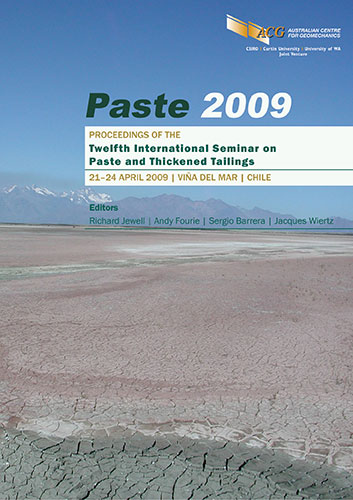Introducing Mathematical Models to Define Settling Curves in Designing Thickeners

|
Authors: Garmsiri, MR; Haji Amin Shirazi, H; Yahyaei, M Paper is not available for download Contact Us |
DOI https://doi.org/10.36487/ACG_repo/963_15
Cite As:
Garmsiri, MR, Haji Amin Shirazi, H & Yahyaei, M 2009, 'Introducing Mathematical Models to Define Settling Curves in Designing Thickeners', in R Jewell, AB Fourie, S Barrera & J Wiertz (eds), Paste 2009: Proceedings of the Twelfth International Seminar on Paste and Thickened Tailings, Australian Centre for Geomechanics, Perth, pp. 129-135, https://doi.org/10.36487/ACG_repo/963_15
Abstract:
Thickener design is based on settling tests and settling curves. In a settling curve, the mud line (interface between the settled pulp and clean water) height is plotted versus time. In this paper three mathematical models are introduced to define settling curves. Approximately 300 settling tests with varying feed solids concentration and flocculant types and dosages using iron, copper, coal, lead and zinc were conducted to verify equations. The coefficient of determination (R2) was used to evaluate the validation of equations. It is shown that with the first model in 98% of cases, and with the second and third models in 99 and 100% of the cases, R2 was greater than 0.99. A quick interpretation of the settling test results, simple determination of critical point and error corrections are considered to be benefits of the presented mathematical models.
References:
Banisi, S. and Yahyaei, M. (2008) Feed dilution based design of a thickener for refuse of a coal preparation plant, Coal
preparation, Taylor and Francis, Vol. 28, No. 4.
Gupta, A. and Yan, D.S. (2006) Mineral processing design and operation, Elsevier publication, Ch. 13.
Henry, W.H. (2002) R-square and standardization in regression, Virginia Commonwealth University, viewed 30 August
Laros, T., Slottee, S. and Baczek, F. (2002) Testing, sizing and specifying sedimentation equipment, Proceedings of
Mineral Processing Plant Design, Practice and Control Conference, Vol. 2, A.L. Mular, D.N. Halbe and D.J.
Barratt (eds), Vancouver, B.C., SME publication, pp. 1295–1312.
Owen, A.T., Fawell, P.D., Swift, J.D. and Farrow, J.B. (2002) The impact of polyacrylamide flocculant solution age on
flocculation performance, International Journal of Mineral Processing, Vol. 48, Elsevier publication,
pp. 3–14.
Purdy, K.L. (1986) Chemical dewatering aids for mineral and coal slurries, Chemical Reagents in the Mineral
Processing Industry, SME publication.
Weir, S. and Moody, G.M. (2002) The importance of flocculant choice with consideration to mixing energy to achieve
efficient solid/liquid separation, Minerals Engineering Journal, Vol. 16, Elsevier publication, pp. 109–113.
Wills, B.A. and Napier-Munn, T. (2006) Mineral processing technology, Elsevier Publication, Ch. 15.
Paste 2009, Viña del Mar, Chile 135
© Copyright 2025, Australian Centre for Geomechanics (ACG), The University of Western Australia. All rights reserved.
View copyright/legal information
Please direct any queries or error reports to repository-acg@uwa.edu.au
View copyright/legal information
Please direct any queries or error reports to repository-acg@uwa.edu.au